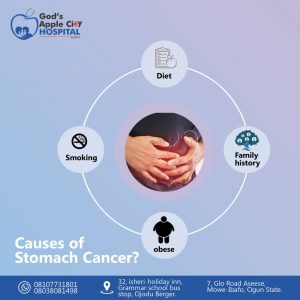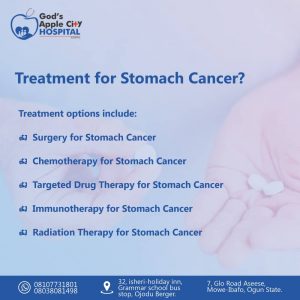What is stomach cancer?
Stomach cancer (also called gastric cancer), cancer cells usually begin on the inner lining of stomach walls and then penetrate deeper into the stomach walls as the cancer develops.
Stomach cancers are classified according to the type of tissue they start in.
- Adenocarcinomas: The most common start in the glandular stomach lining.
- Lymphomas: Develop from lymphocytes, a type of blood cell involved in the immune system.
- Sarcomas involve the connective tissue (muscle, fat, or blood vessels).
- Other types include carcinoid, small cell carcinoma, and squamous cell carcinoma.
- Metastatic cancers from breast cancer, melanoma, and other primary sites of cancer are also seen in the stomach.

What causes stomach cancer?
- Smoking
- Being overweight or obese
- A diet high in smoked, pickled, or salty foods
- Drinking alcohol regularly
- Stomach surgery for an ulcer
- Type-A blood
- Epstein-Barr virus infection
- Certain genes
- Working in coal, metal, timber, or rubber industries
- Exposure to asbestos
- Family history

What Are the Symptoms of Stomach Cancer?
Stomach cancer may cause:
- Vomiting
- Loss of Appetite
- Heartburn
- Nausea
- Upper Abdominal pain

What Are Stomach Cancer Treatments?
Many treatments can fight stomach cancer. The one you and your doctor choose will depend on how long you’ve had the disease or how much it has spread in your body, called the stage of your cancer:
Stage 0. This is when the inside lining of your stomach has a group of unhealthy cells that may turn into cancer. Surgery usually cures it. Your doctor may remove part or all of your stomach, as well as nearby lymph nodes — small organs that are part of your body’s germ-fighting system.
Stage I. At this point, you have a tumor in your stomach’s lining, and it may have spread into your lymph nodes. As with stage 0, you’ll likely have surgery to remove part or all of your stomach and nearby lymph nodes. You might also get chemotherapy or chemo radiation. These treatments can be used before surgery to shrink the tumor and afterward to kill any cancer that’s left.
Chemotherapy uses drugs to attack cancer cells. Chemo radiation is chemo plus radiation therapy, which destroys cancer cells with beams of high energy.
Stage II. Cancer has spread into deeper layers of the stomach and maybe into nearby lymph nodes. Surgery to remove part or all of your stomach, as well as nearby lymph nodes, is still the main treatment. You’re very likely to get chemo or chemo radiation beforehand, and you might get one of them after, too.
Stage III. The cancer may now be in all layers of the stomach, as well as other organs close by, like the spleen or colon. Or, it may be smaller but reach deep into your lymph nodes.
You usually have surgery to remove your entire stomach, along with chemo or chemo radiation. This can sometimes cure it. If not, it can at least help with symptoms.
If you’re too sick for surgery, you may get chemo, radiation, or both, depending on what your body can handle.
Stage IV. In this last stage, cancer has spread far and wide to organs like the liver, lungs, or brain. It’s much harder to cure, but your doctor can help manage it and give you some relief from symptoms.
Treatment options include:
- Surgery for Stomach Cancer
- Chemotherapy for Stomach Cancer
- Targeted Drug Therapy for Stomach Cancer
- Immunotherapy for Stomach Cancer
- Radiation Therapy for Stomach Cancer

.
.
.
.
.
https://web.facebook.com/Godsapplecity
read other blogs https://godsapplecityhospital.com/breast-cancer-signs-and-detection/

